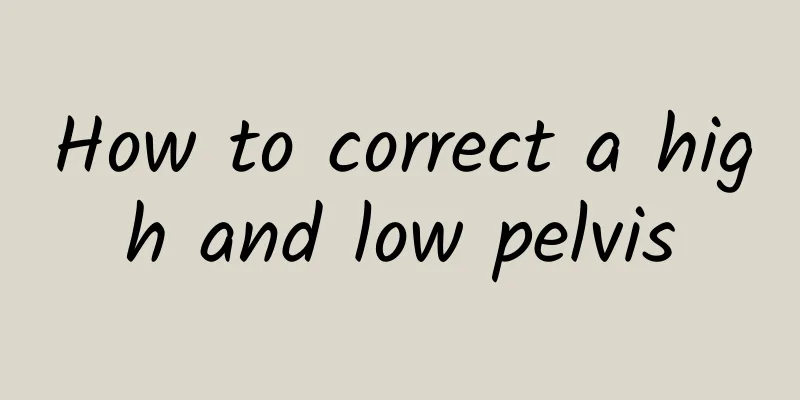How to correct a high and low pelvis

|
Good health is the most important thing for us, but with the improvement of living standards, diseases will still occur. The pelvis is an important part of our body. If there are symptoms of pelvic disease, timely treatment is needed. Especially in work and life, we will encounter various diseases. It is common for the pelvis to be of different heights. This can be improved through correction methods. How can one high and one low pelvis be corrected? 1. Different conditions of the pelvis When the pelvis attempts to complete its forward motion, the abdomen protrudes forward and the pubic symphysis pulls downward. The muscles required to complete this movement are mainly the erector spinae muscles and the iliopsoas muscles. If you are standing, the femur and spine are in a fixed state. At this time, the erector spinae muscles pull the sacrum upwards, and the lumbar spine bends forward. At the same time, the iliopsoas muscles cooperate to make the pelvis move forward. In addition, the multifidus muscles on both sides of your body will contract, and the external rotator muscles of the hip joint and the upper abdominal muscles will stretch to facilitate the smooth forward tilt of the pelvis. 2. Pelvic Exercise When you want to tilt the pelvis posteriorly, the main muscle groups are the gluteus maximus and hamstrings. At the beginning of the movement, these two muscle groups begin to contract, causing the sitting bones to move downward. At the same time, the hip external rotators and abductors work together, and the iliopsoas muscle will produce a relative force stretch to the action of the gluteus maximus, causing the pelvis to tilt backward. 3. Up and down tilt of the pelvis For the pelvis, rising and falling are relative movements. If one side of your pelvis rises, the other side will definitely fall accordingly. When one side of your pelvis wants to lift, the main muscles involved are the external obliques, internal obliques, and quadratus lumborum. At the same time, your psoas and erector spinae muscles will move in tandem, flexing your flank and pulling the pelvis upward on the same side. While one side rises, the other side falls, which involves the gluteus medius and gluteus minimus. At the same time, in order to maintain the balance of the body, the lateral abdominal muscles will also stretch to move the pelvis downward. 4. Pelvic rotation The rotation mentioned here is mainly at a horizontal angle, and the pelvis rotates around the spine as the axis. To rotate the pelvis, the following steps are required: the external oblique muscles on one side contract to move the pelvis posteriorly, and the multifidus, gluteus maximus, and hamstrings on the same side and the iliopsoas on the other side work together. This ultimately results in a horizontal rotation of the pelvis. 5. Ways to get rid of pelvic tilt After talking about the movement of the pelvis, let’s take a look at the deviation of the pelvis and what causes it. It is also explained in the order above. However, before we begin, we still need to emphasize the improvement of lifestyle habits. Pay attention to your sitting posture in daily life. Sit on a chair, keep your feet and knees together, and tighten your buttocks. After sitting down, relax your hips and place your feet together. Keep your head up, back straight, and shoulders relaxed. Walking posture is also important, and the center of gravity should be on the forefoot when walking. When taking the first step, point your toes slightly outward, keep the soles of your feet in the same straight line, and use your thighs to drive your calves forward. Keep your head and chest up, look straight ahead, do not shake your shoulders when walking, stay relaxed, and let your arms swing naturally at both sides of your body. The stride is about shoulder-width apart, with the knees slightly rubbing against each other. Lifting the hip joint upward will create a natural, dynamic curve in the hips when walking. For the standing posture, just stand naturally, tighten your buttocks muscles, clamp a thin magazine between your thighs, and use force on the inner sides of your legs to prevent foreign matter from falling to the ground. Keep your shoulders relaxed and look forward. Straighten your upper body, bring your legs together, and use your big toes and second toes to push. |
<<: Can rock sugar be added to Chinese medicine?
>>: What are the dangers of excessive folic acid in pregnant women?
Recommend
What does TCM Internal Medicine mainly focus on?
Traditional Chinese medicine is a traditional tre...
What does spontaneous sweating mean?
Exterior deficiency means frequent sweating. Due ...
Self-acupoint pressing method in meridian health care
With the enrichment of material life, many people...
Is advanced lung cancer contagious?
People may have many things to do in their lives,...
Do two things before going to bed to cure all diseases
The increase in life pressure and the faster pace...
What are the early symptoms of adnexal cysts?
As the tumor grows, the patient will feel symptom...
Itchy blisters all over my body like mosquito bites
If you feel a lump on your body, like a mosquito ...
What to do if you have a right cornual pregnancy?
Pregnancy is the top priority in a woman's li...
Can acne tumors be cured without surgery?
Pyroma is a relatively common disease manifestati...
How to clear blocked meridians throughout the body
The human body is composed of many meridian parts...
What are the dangers of ear acupuncture?
After the ear is diseased, western medicine can r...
Is agarwood poisonous?
As people's life pressure increases, their bo...
Can ginger and licorice be taken together?
Licorice and ginger are both treasures of life, w...
What is the reason for the red spots under the baby's heel
When red spots appear under the skin of the baby&...
The efficacy and function of fish and turtle grass
Fish and turtle grass and fish and turtle Uranus ...









